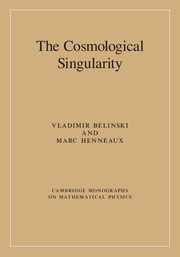Book contents
4 - On the Influence of Matter and Space-Time Dimension
from Part I - BKL Analysis
Published online by Cambridge University Press: 24 October 2017
Summary
Introduction
In the preceding sections we have established the existence of a general cosmological solution of the gravitational equations with a singularity with respect to time, and have studied the asymptotic properties of this solution near the singularity. We saw that in this limit the solution may be described by an infinite alternation of Kasner epochs. The notion of a Kasner epoch and the transition between two of these are the key elements in the dynamics of the oscillatory regime.
We have derived and studied these properties in the example of empty space in four space-time dimensions. In this chapter, we investigate how the analysis can accommodate matter sources, as well as a change in the space-time dimension.
We will successively consider the following systems. First, we consider perfect fluids in four space-time dimensions. Next, we consider gauge fields of the Yang-Mills and electromagnetic types and scalar fields, also in four space-time dimensions. Then, we discuss pure gravity in higher dimensions. Finally, we outline some results on the character of the cosmological singularity in presence of a viscous matter source. In Appendix C, we solve the case of a commuting spinor field. This case is mathematically interesting but its physical significance is not clear (because the spinors are treated as classical c-numbers).
We shall see that in certain important cases the influence of matter upon the solution in the vicinity of the singularity appears to be qualitatively negligible. This is, for instance, true for the case of standard perfect fluid. For other (less simple) types of the energy–momentum tensor, the influence of matter proves to be more important, but it can still be analyzed analytically with sufficient clarity and along the same general lines. We will also find the surprising result that in space-time dimensions equal to or higher than 11, D ≥ 11, gravity near a cosmological singularity ceases to be chaotic [63, 62].
We follow in this chapter the original BKL approach. The same analysis can be performed using the billiard description. It is given in Chapter 6; see in particular Section 6.6.
- Type
- Chapter
- Information
- The Cosmological Singularity , pp. 57 - 94Publisher: Cambridge University PressPrint publication year: 2017

